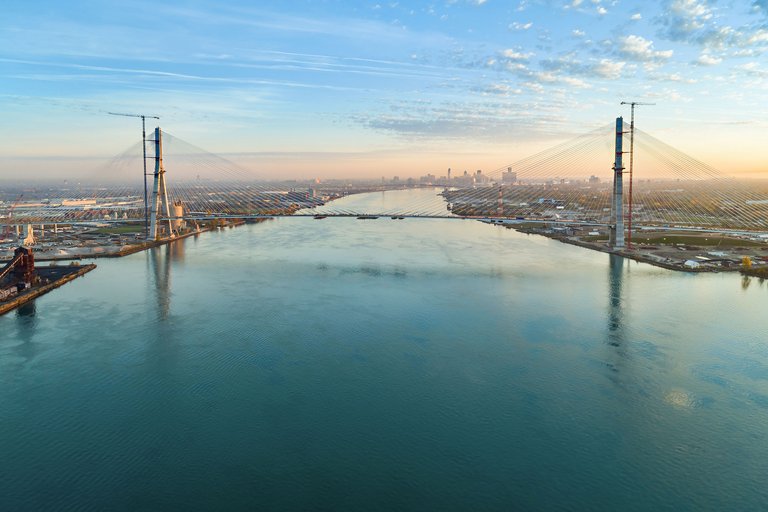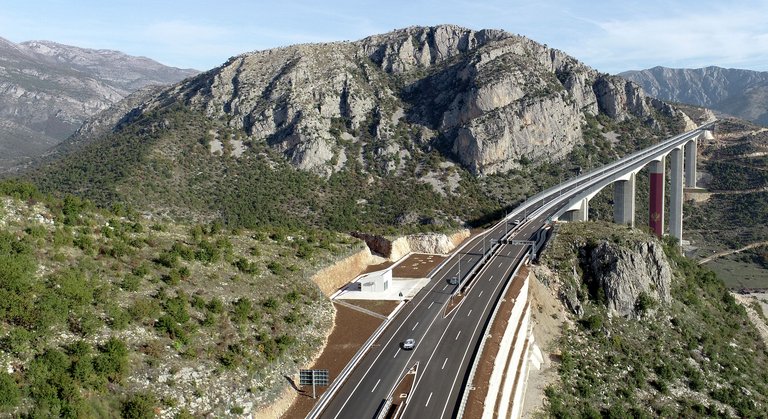
Lasting infrastructure Redefining durability for lasting infrastructure
Building resilient structures improves safety and extends the lifespan of critical infrastructure. By focusing on durability, Sika solutions also enable economic benefits, reduce total cost of ownership, and contribute to decarbonization efforts.
The demand for infrastructure projects – from new builds to repair, replacement, and refurbishment – remains strong. With a wide range of innovative solutions to enhance the durability of existing and newly built structures, Sika is ideally positioned in this market.
In the United States alone, over 35% of the 617,000 bridges are in need of repair or replacement1. Many are approaching or past their designed lifespan, requiring substantial refurbishment. In response, the Infrastructure Investment and Jobs Act (IIJA) has authorized more than one trillion US dollars for infrastructure projects. The projects funded will increase the lifespan of bridges, roads, and tunnels, modernize transportation infrastructure, improve safety, reduce congestion, and ultimately boost economic growth.
Globally, up to 40% of bridges, particularly in mature or less-developed regions, require significant repair or replacement2. At the same time, emerging economies specifically are keen to reap the social and economic benefits of building new roads, tunnels, and bridges.
How Sika Supports Global Infrastructure: Three Examples
Whether the solution is a new build, repair or replacement of existing infrastructure, durability is paramount. Higher durability – and thus a longer lifespan – reduces the total cost of ownership by lowering the need for maintenance, repairs, and replacements over the structure’s service life. At the same time, it supports decarbonization by reducing embodied carbon from material production and waste.
As Kyle Loyd, Executive Vice President Commercial Construction at Sika USA, explains: “One of Sika’s strengths is our broad product portfolio. In bridge construction, for example, we offer the most comprehensive range of solutions for both new construction and the refurbishment of existing structures.”
UPGRADING EXISTING INFRASTRUCTURE IN ESTABLISHED ECONOMIES
Sika is making a significant impact on several major projects in the United States. A high-profile project is the Gordie Howe International Bridge, built to improve trade and travel between Canada and the United States. With a CHF 4 billion investment, this impressive structure is the largest and most ambitious binational infrastructure project along the border. Spanning 2.5 kilometers, the bridge features two 220-meter towers, making it the longest cablestayed bridge in North America3. Designed to accommodate six traffic lanes and pedestrian pathways, the bridge incorporates advanced engineering to ensure durability, seismic resilience, and optimal performance under heavy use.
The Gordie Howe International Bridge also features the longest expansion joints in North America, supplied by Watson Bowman, a Sika brand. These advanced joints are engineered to accommodate the bridge’s high traffic volume as well as significant thermal and structural movement caused by fluctuating weather conditions. In addition, Sika played a key role by supplying concrete admixtures for all structural elements, ensuring the bridge’s strength and longevity.
Gordie Howe International Bridge,
North America
Connecting USA and Canada
The six-lane Gordie Howe International Bridge crosses the Detroit River, connecting Detroit (USA) with Windsor (Canada). It is central to trade between the two countries and will experience heavy usage after its opening later this year.
#1
Gordie Howe International is the longest cable-stayed bridge in North America and one of the 10 longest cable bridges globally.
Length
2.5 km
Number of lanes
6
Modular expansion joints
Length of modular expansion joints
200 meters
1 Neoprene rubber seals
2 Structural steel edge member and beams
Durable joint
During the lifespan of a modular expansion joint, vehicles will travel over it more than 1,000,000 times.
Other examples of important projects include the Hudson River Tunnel, which links New Jersey to New York City, and the construction of a new companion bridge alongside the renovation of the Brent Spence Bridge, connecting Ohio and Kentucky.
Sika’s acquisition of Kwik Bond, a leading manufacturer of polymer systems for concrete infrastructure, has also provided the overlay for the new Goethals Bridge in New York. These solutions not only extend the lifespan of roads and bridges, but also repair surface cracks effectively. Kwik Bond’s innovative repair and preservation systems offer a durable 30-year solution, and enable traffic to resume just two hours after application.
NEW INFRASTRUCTURE IN FAST-GROWING MARKETS
Large infrastructure projects are not limited to the United States. In Montenegro, Sika is playing a key role in the construction of the Bar-Boljare highway, one of the country’s most significant infrastructure projects. Designed to connect Montenegro’s coast with its northern region and extend further into Serbia, the highway will enhance transportation, reduce travel time, and drive economic growth. This project is also part of the broader Adriatic – Ionian highway initiative, which aims to connect the Adriatic Sea countries with Western Europe.

“One of Sika’s strengths is our broad product portfolio. In bridge construction, for example, we offer the most comprehensive range of solutions for both new construction and the refurbishment of existing structures.”
Executive Vice President Commercial Construction
The first 41-kilometer section, a quarter of the total length, features 16 tunnels and 20 bridges built under demanding geological and climatic conditions. The most significant construction achievements on this section include the Moračica Bridge, which, with its height of 175 meters and length of 960 meters, ranks among the tallest bridges in Europe, as well as the Vjeternik Tunnel, the longest tunnel on the highway, with a length of more than three kilometers.
M-2 Highway,
Montenegro
Highway in challenging terrain
The M-2 Highway, Smokovac–Mateševo section, traverses challenging terrain with numerous tunnels and bridges.
Total length
164 km
Expected completion
2030
Montenegro’s diverse climate also added complexity to the project, with extreme temperature variations and annual rainfall of up to 7,000 mm in the southern mountains.
The first 41-kilometer section, a quarter of the total length, features several tunnels and bridges built under demanding geological and climatic conditions.
16 tunnels
with total length of 17.7 km
20 bridges
with total length of 6.35 km including ramps
Sika contributed key solutions to overcome these challenges, including advanced concrete admixtures that enhanced resistance to temperature fluctuations and mechanical stress. The company also supplied waterproofing systems to prevent water ingress and specialized mortars for concrete surface protection and repair, ensuring long-term durability.
In Vietnam, Sika is contributing to the construction of a 530-kilometer section of the North–South Expressway East, a transformative infrastructure project that will improve connectivity across the country. This section, spanning seven provinces with varying geological and climatic conditions, is the final part of the 2,063-kilometer expressway that will link Vietnam’s northern and southern regions. Upon completion later in 2025, the expressway will improve transportation efficiency for more than 60% of the country’s population, facilitate trade, and strengthen links to 16 airports, seaports, and major economic centers 4.
This ambitious project presents significant engineering challenges, including unstable soil conditions, high humidity, and heavy rainfall. To address these complexities, Sika has supplied high-performance solutions, such as shotcrete accelerators for tunneling, concrete superplasticizers to enhance workability and strength, and cementitious grouts for structural reinforcement. In addition, Sika’s technical expertise has been instrumental in optimizing concrete production and ensuring durability in this demanding environment.
North–South Expressway East,
Vietnam
The North–South Expressway improves transportation for 62% of the population.
Length
2,063 km
Expected completion
2025
Airports connected
16
Challenging climatic conditions
Vietnam’s diverse climate, spanning 15 degrees of latitude, presents significant challenges for road construction.
Driest area
400 mm/year
Wettest area
8000 mm/year
Extreme conditions
Ground temperatures tend to be +30°C above air temperature
Maximum air temperature
>44°C
Minimum air temperature
<–6°C
By delivering advanced construction solutions and expert support, Sika is helping to build modern, resilient infrastructure that will drive long-term economic growth.
